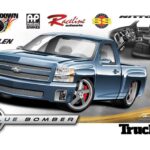The GM Turbo 350 transmission, also known as the Chevrolet-Buick Combined Transmission or CBC 350, has left an indelible mark on the automotive industry. This 3-speed, automatic shift transmission debuted in 1969, ushering in a new era as it succeeded GM’s Powerglide automatic transmission.
This blog post will look at the characteristics, features, and applications of the Turbo 350 transmission.
Turbo 350 Transmission: Evolution and Development
Born from a collaborative effort between Buick and Chevrolet, the Turbo 350 transmission rapidly gained recognition for its compact yet robust design, imbued with strength and versatility. Its ideal balance of size and power made it a popular choice for smaller vehicles, easily fitting into their engine compartments. As a result, it found its way into a diverse array of rear-wheel-drive GM cars and trucks.
The Turbo 350 transmission’s reign extended for nearly 15 years until it gradually yielded its place to the 700R4 transmission, introduced in 1982. Nevertheless, it continued to excel in vehicles equipped with V6 and V8 small block engines, thanks to its formidable performance.
In 1980, an innovative lockup torque converter was introduced for the Turbo 350. Still, its journey was cut short just four years later due to challenges related to inconsistent acceleration and downshifting. Ultimately, production of the venerable Turbo 350 transmission stopped after 1984.
Characteristics Of Turbo 350 Transmission
One of the most distinctive features of the Turbo 350 transmission is its almost non-existent central support, a stark contrast to the TH400. This unique design allowed it to be seamlessly installed in vehicles like the Corvair. Its nearly identical ends wouldn’t have been possible if it featured central support.
To improve cooling, the Turbo 350 transmission received crucial enhancements, including an air baffle and air intakes on the torque converter. However, it’s worth noting that these air intakes can also serve as pathways for debris to enter the internal components, underscoring the importance of regular cleaning and maintenance.
Prominent models like the Vega and Nova 6 proudly showcased this air-cooled transmission feature.
Features and Upgrades
The Turbo 350 transmission exhibits versatility in its band specifications and clutch, often tailored to match the engine’s power output. Upgrades are readily available to enhance its performance, including shift improver kits designed to reduce clutch wear, minimize heat buildup, and deliver smoother and quicker shifts. For high-power applications, a more robust torque converter can be seamlessly integrated.
The Turbo 350 transmission is a versatile and adaptable component in automotive transmissions. One of its key attributes lies in its ability to accommodate a range of specifications to match the power output of various engines. This adaptability makes it a favored choice among auto enthusiasts and mechanics alike.
Customization: Adjustments To Band Specifications
One of the noteworthy aspects of the Turbo 350 transmission is its ability to be customized to suit specific needs. This customization often involves adjustments to the band specifications and the clutch system. Mechanics and performance enthusiasts can optimize the transmission’s performance by fine-tuning these components to align with the engine’s power characteristics. This level of precision ensures that the transmission operates at its peak efficiency, delivering the best possible performance.
Other Upgrade Options
Furthermore, the Turbo 350 transmission benefits from various upgrades that cater to different requirements. One such upgrade option is the installation of shift improver kits. These kits are engineered to enhance the transmission’s overall performance in several ways.
They contribute to reducing clutch wear, essential for extending the transmission’s lifespan. Additionally, they play a crucial role in mitigating heat buildup within the transmission, a common concern in high-stress situations. This heat reduction helps preserve the integrity of the transmission components and ensures consistent performance over extended periods.
Upgrade The Torque Converter
Perhaps one of the most sought-after upgrades for the Turbo 350 transmission is installing a more robust torque converter. In high-power applications, where engines produce substantial horsepower and torque, the stock torque converter may struggle to handle the increased demands.
Upgrading to a more robust torque converter allows the transmission to manage the power generated by high-performance engines seamlessly. This prevents premature wear and tear and ensures smooth and efficient power transfer, resulting in improved acceleration and overall performance.
Turbo 350 Transmission: Versatility & Adaptability
In summary, the Turbo 350 transmission’s versatility and adaptability are exemplified through its capacity for customization and the availability of performance-enhancing upgrades. Whether it’s adjusting band specifications, optimizing the clutch system, or integrating a more robust torque converter, these options empower automotive enthusiasts to fine-tune their transmissions to meet the specific demands of their engines.
This flexibility has solidified the Turbo 350 transmission as a favored choice for various automotive applications, from daily drivers to high-performance machines.
Turbo 350 Transmission Specs/Options
When the Turbo 350 transmission debuted, it swiftly replaced the Powerglide 2-speed automatics.
Here are the essential gear ratios for the Turbo 350:
-
First gear: 2.52 to 1
-
Second gear: 1.52 to 1
-
Third gear: 1.0 to 1 (direct drive)
-
Reverse: 2.07 to 1
While the Turbo 350 may lack an overdrive gear, it excels in powering classic American muscle cars. It offers a range of performance options to cater to various needs:
-
GM Turbo 350 transmission Level 2: $3,495.00
-
GM Turbo 350 transmission Level 3: $4,495.00
-
GM Turbo 350 transmission Level 4: $5,995.00
These options are tailored to accommodate different power levels and performance requirements.
Construction and Versatility
The Turbo 350 transmission is a single-piece unit, seamlessly integrating a bell housing into its body with a cast aluminum casing. Its short length and lightweight design make it versatile for various applications. While the transmission typically holds 4 quarts of fluid in the pan, the amount can vary based on the torque converter. In conjunction with a 9.5-inch torque converter, it can handle up to 10 quarts of fluid.
Applications
The Turbo 350 transmission found widespread use in numerous vehicles, including GMC trucks, Caprice, Pontiac Firebirds, Monte Carlo, Chevrolet Camaro, and many more. An offshoot version was even developed to complement Buick, Oldsmobile, and Pontiac (BOP) vehicles, designed explicitly for Pontiac V8 engines. Distinguishing between the standard Turbo 350 and the BOP version could be done by examining the block flange.
Concluding Comments
In conclusion, the GM Turbo 350 transmission played a pivotal role in the automotive landscape during its era, offering an enticing blend of compactness and robustness. Although it may no longer be in production, its legacy lives on in countless vintage vehicles, celebrated for its durability and versatility.
The Bottom Line
This transmission’s extra gear conferred a significant advantage over its predecessors, solidifying its status as a reliable choice for an array of applications in classic automobiles.
Ready to experience top-notch transmission solutions and expert support?

